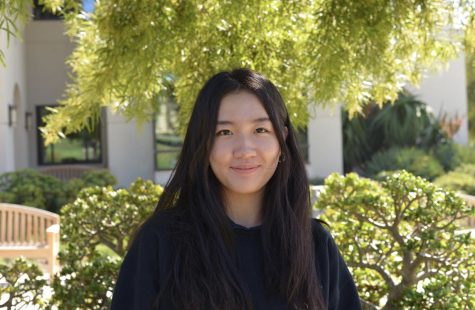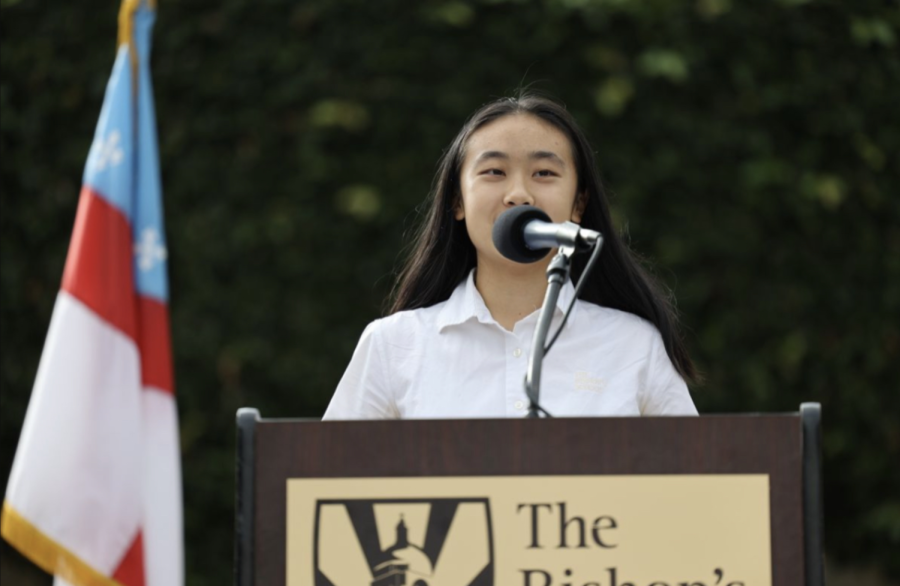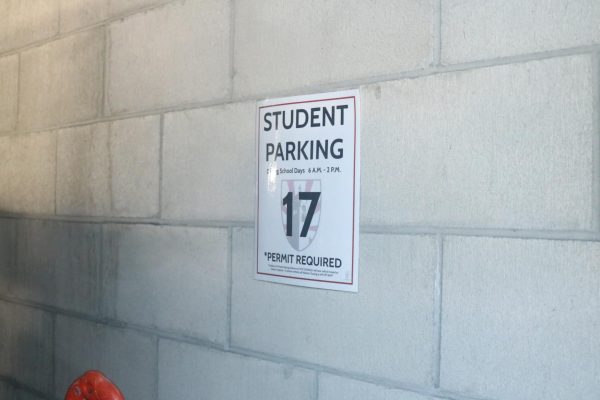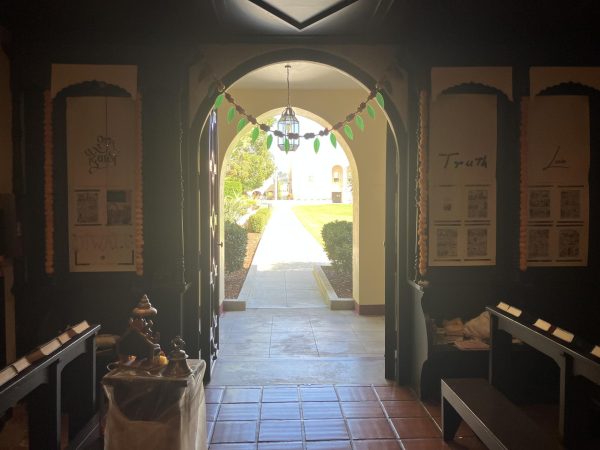Senior Class President Katelyn Wang: Artist and Activist
Katelyn Wang (’23) spoke to our school community during the 2021 Thanksgiving Chapel about her appreciation for her figure skating coach.
As a part of the 1.7% of students selected from over 91,000 national applicants, Katelyn Wang (‘23), alongside Athena Hernandez (‘23), was one of Bishop’s 2023 Coca-Cola Scholars Foundation Semi-Finalists. Katelyn believes that this recognition was a result of her work exploring social justice and implementing it in her personal communities.
From serving Bishop’s DEIJ program and East Asian Student Association (EASA), to leading the class of 2023 as president, to supporting organizations like San Diego Asian Pacific Islander Coalition, Katelyn dedicates writing, art, and conversations to support racial justice. Looking back as a second-semester senior, Katelyn expressed her appreciation and gratitude for the person Bishop’s and San Diego helped her to be. “I will never forget who I truly am: a San Diego advocate, nurtured on the Bishop’s campus, seasoned in Convoy, with a mind of infinite ambitions,” she noted meaningfully.
The Coca-Cola Scholars Foundation states on its website that winners are selected “based on their academic excellence, leadership, and service demonstrated in school and community activities.” What project did you do for you to receive this recognition?
I believe the accumulation of my efforts resulted in this recognition. I’m an opportunistic individual who seeks to explore equity across various disciplines — intellectual and creative. Whether that is through literature, policy work, art, or dance, I’m driven by my dedication to social justice. I’ve always been chasing that dream of changing the world: I embrace outlets both in and out of school to grow this passion.
At Bishop’s, I’ve been involved in the efforts of our DEIJ program plus student government. I view the school community as a microcosm of the greater world, so it feels important for me to address issues like justice education, nurturing cultural appreciation, and bringing inclusivity to campus. I find affinity groups to be a very empowering space, so I use my leadership for the East Asian Student Association (EASA) and within the Regional Student Diversity Summit (RSDS) to bring that power to others. In student government, I enjoy representing my class and contributing to activities ranging from planning large school events, advocating for cultural celebrations, to following the installment of pad/tampon dispensers across campus! Through these works, I’ve been able to connect with community members on a deeper level and work towards my visions of a better Bishop’s.
Outside of school, I devote much of my time to the San Diego Asian Pacific Islander Coalition. As a Youth Advocate, I’ve gotten the chance to speak with political figures like San Diego Mayor Todd Gloria and Attorney General Rob Bonta: these experiences allowed me to gain insight into the complexities of policy, while uplifting youth advocacy platforms. Outside of community-event advocacy, I worked over the summer to reach out to schools in diverse regions. I sought to connect with various youth leaders from different backgrounds. Currently, I direct the Youth Network, which seeks to empower our future generation through events like channeling youth into political campaigns, providing service opportunities, instigating a guest speakers network, and joining in person to support API empowerment galas.
How did your passion for activism begin and how did Bishop’s help facilitate your interests?
I first found my passion for activism on the Bishop’s campus amidst the Stop Asian Hate movement. At the time, I felt a strong urge within me to create more mindfulness within the community and address current events. I utilized various resources, like article writing in the DU and speaking with the administration, to initiate events on campus centered around uplifting the Asian community. This passion for advocating for my own identity grew into one of embracing equity within the broader community. I became fascinated with the impact of representation and policy, whether that was in the classroom or beyond. As I learned about academic concepts like redlining and historical misrepresentation, I joined conversations regarding those topics within my API Coalition community.
For example, to combat 1990s redlining and recent economic policies that removed parking spaces from Asian businesses, we promoted Kent Lee’s API empowerment district campaign to institute our governmental power. I couldn’t withhold my excitement for diversifying politics — at Bishop’s, I spearheaded efforts to address voter registration gaps by analyzing census tracts and writing 200+ campaign postcards targeting politically inactive neighborhoods.
I became very involved with affinity groups at Bishop’s and found myself engaged with the DEIJ program. After our DEIJ program faced hardships, I spent one summer at a Leadership Institute program connecting with schools across the nation that were also on the journey of justice education. This allowed me to branch out and understand the perspectives of regionally diverse, multifaceted, public, and all around, different, schools.
You’re also an active artist on campus, on social media, and in your personal life — what were your experiences as an artist like?
My art has also grown alongside this journey. Initially, I created art for the Black Lives Matter movement to educate myself on the significance of that civil rights fight for African Americans. I found the transformative power of art to coincide perfectly with my passion for political advocacy. Through the years, my art has become bigger — like, physically. One result of my activism has been my Justice Mural in Bentham. I look to use art creation to create mindful community members and have centered my Independent Study around bringing the power of art to local youth through collaborative learning and creation.
What’s your mission with your project? What impact would you like to leave?
My mission is to build more inclusive communities, where all youth believe that they can be a part of social change, whether that is at school or in the broader community. While running in the ASBC and Class Council elections, I embraced a campaign platform that put students at the core of my work. Through the cat memes and honest speeches, I hope to have shown students that there exist numerous networks for them to initiate real-time change at school—that it is fully possible to tackle greater notions of diversity and representation. I’m someone very dedicated to my school, so I hope my works empower younger students and inspire them to dream big about shaping the Bishop’s community.
When I work with students outside of Bishop’s, I find that I’m very lucky to have my resources. Many other schools deal with grave issues of misrepresentation and inequity but lack the means to address those issues the same way I can. This is why I facilitate collaborations to make my network centered around inclusion: I aspire to use my role in the Bishop’s community to advance our progress in justice education while always reaching out to other communities. As a Youth Advocate, I hope my impact lies in all the individuals that I am able to unite with.
I also hope that people remember me by my art. I mean, physically, my Justice Mural in Bentham is an example of physical impact. But beyond that, I hope its message of inspiring mindfulness never becomes still. I share my voice through my art, and I hope that voice is fluid and never silenced.
What were some of the roadblocks that you’ve encountered in your journey?
Stepping out of Bishop’s, I realized how broad the spectrum of political advocacy is. Being a part of Bishop’s has offered me extraordinary connections and resources to embark on social justice matters. However, in other regions, that is not the reality. When I seek to advance social justice initiatives through my Youth Network, not all regional groups have adequate resources to apply my ideas or contribute to the same extent. For example, when we collaborate in person, I enjoy meeting in our Convoy office; however, that distance is inaccessible to many youths, pushing me to think of more inclusive means of connection.
When I was outreaching communities in Southern California, there were more schools with greater Filipino student populations, many of whom felt a lack of connection with the larger East-Asian populations in the North. I took this opportunity to travel to Chula Vista and connect with groups like the Asian Solidarity Collective, which consists of many Filipino youth leaders, in order to understand their narratives and form connections broadening the SD Asian Pacific Islander Coalition. I’ve worked to amplify specific resources that can be used for various identities and ensure that the network respects people from all walks of life.
Who were your biggest supporters along the way?
My biggest supporters have definitely been my parents, various teachers at Bishop’s, and my friends at the SD API Coalition. When I first started my advocacy work, my parents feared I was being too outspoken — as I leaned into my fearlessness, they feared for my safety, and rightfully so during the rising anti-Asian hate crimes. However, I am grateful for their trust in allowing me to embrace what I love most, no matter how risky it may have seemed.
I’m also indebted to [Director of Diversity, Equity, Inclusion & Justice] Mr. Thompson, who was there for my first conversation and infinite ones afterward. He exemplified patience in listening to my story, and he is the reason I’m connected with the SD API Coalition. It’s crazy how some people can envision your potential better than you can yourself. From celebrating with Mr. Thompson at the Pride Festival to sharing the same adult friends, he has brought me endless memories. My peers at the SD API Coalition have really brightened my journey. They help me speak at various events, support my advocacy, taught me how to campaign effectively, and make sure I never miss out on the best Asian food!
How will you continue your work in the future? In college and beyond?
I envision my Youth Network encompassing further regional diversity and working as an outlet for all leaders to rely on. Before leaving San Diego next year, I aspire to form deeper connections with this place and meet with as many leaders as possible. In the larger college community, I seek to be a part of projects and networks that advance political equity through inclusive means. To me, college means further opportunities to connect with people from all walks of life, and I look forward to feeling inspired by everyone I meet. Still, I will never forget who I truly am: a San Diego advocate, nurtured on the Bishop’s campus, seasoned in Convoy, with a mind of infinite ambitions.
As I pursue academic coursework in college, I can’t wait to extend my drive for justice to subjects of study. I’ve enjoyed interdisciplinary work such as merging writing with political advocacy, whether that came in the form of poetry or legislative essays. My next academic journey will allow me to grow that intellectual approach. I also look forward to embracing new communities through art. My art creation process is very community focused, so I look to sharing my story with others while finding fresh collective visions to expand into innovative creations.
Congratulations are in order for Katelyn, and feel free to reach out to her to have a conversation about her accomplishments or if you have any questions!

Crystal Li joined The Tower in her freshman year when she moved from Shanghai to San Diego in 2019. Now a senior, she fondly looks back on the four-year...






